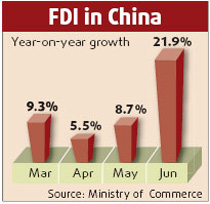The successful listing debuts of Bank of Nanjing and Bank of Ningbo, the first two city lenders to go public, are expected to spur a new round of city bank listings.
Top officials of seven other city banks, including Bank of Shanghai, Bank of Beijing, Bank of Chongqing and Bank of Hangzhou, are publicly talking about their own listing plans.
"After most State-owned banks went public, listings by the city banks are expected to become a trend and a new focus for investors," says Shi Lei, an analyst at Tianxiang Securities.
Except for the Agricultural Bank of China, all other State-owned banks - Bank of China, Industrial and Commercial Bank of China (ICBC) and China Construction Bank - are already listed on the mainland stock market. Many joint-stock banks, such as China Citic Bank, Industrial Bank and China Merchants Bank, have also been listed.
Cai Esheng, vice-chairman of the China Banking Regulatory Commission (CBRC), told a recent forum that the government would support qualified city banks in public listings, according to China Securities News.
Analysts say city banks have unique characteristics and advantages that can help them better serve small- and medium-sized companies and because of that they have large profit growth potential.
"City banks have the advantages of being familiar with the local market so that they can create more localized, innovative products," says Ren Zhuang, an analyst at Industrial Securities.
The total assets of city banks grew 28.3 percent in the first quarter this year, while that of joint-stock banks increased 22.5 percent and assets of State-owned banks grew 14 percent in the same period.
Non-performing loans in city banks have declined in recent years, down from 7 percent in May 2005 to 4.52 percent in May 2007.
Average capital adequacy ratios in city banks rose from 7.12 percent to 8.48 percent at the end of 2006, higher than the minimum of 8 percent required by the CBRC. The capital adequacy ratio of Bank of Nanjing was 11.71 percent while that of Bank of Ningbo was 11.48 percent.
A total of nine city banks have attracted foreign strategic investors, including those in Shanghai, Nanjing, Xi'an, Ji'nan, Beijing, Tianjing, Hangzhou, Nanchong and Ningbo.
BNP Paribas of France owns 12.15 percent of Bank of Nanjing and Singapore's Overseas Chinese Banking Corp owns around 10 percent of Bank of Ningbo.
"The performance of city banks has greatly improved after introducing foreign investors, especially in the areas of operational management and risk prevention," says He Sheng, an analyst at Changjiang Securities.
Analysts note that most city banks are developing through foreign strategic investors introducing initial public offerings for cross-regional and national expansion.
After establishing its first branch in Taizhou, Bank of Nanjing has submitted an application to the CBRC to set up a branch in Shanghai and one in Hangzhou. "The speed of branches opened and the locations the bank chooses are the key factors leading to profit growth," says He.
Bank of Ningbo opened its Shanghai branch in April, and plans a branch in Nanjing by the end of this year, as well as one in Hangzhou.
"The bank is expected to open around two to three branches a year, mainly located in the Yangtze River region," says He.
The performance of city banks in the well-developed eastern regions was often better than those in less-mature middle and western regions. The eastern coastal region offer much greater business opportunities from higher local government revenue, an active private business sector and higher personal incomes.
Yet risks exist in the development and expansion of city banks, most of which are too concentrated in service and loans to top-10 clients that account for a high percentage of their business, exposing them to credit risks and policy changes.
"Some city banks have a higher proportion of investment in corporate bonds. Once the government raises the interest rate or takes other economic controls, the bank may make a loss on corporate bonds," says He.
He adds that city banks should control internal risks in the asset expansion to prevent their bad loan ratio from increasing.
By the end of 2006, there were 114 city banks in China with total assets of 2.6 trillion yuan.
(China Business Weekly August 6, 2007)


